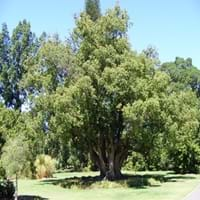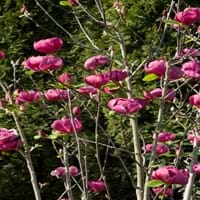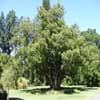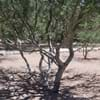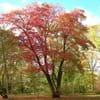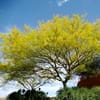Life Span
Perennial
Perennial
Origin
India, China
Hybrid origin
Types
Bead tree
Not Available
Habitat
Forest margins, Roadsides
Moist Soils, Well Drained
USDA Hardiness Zone
8-15
5-9
Sunset Zone
H1, H2, 6, 7, 8, 9, 10, 11, 12, 13, 14, 15, 16, 17, 18, 19, 20, 21, 22, 23, 24
2b, 3a, 3b, 4, 5, 6, 7, 8, 9, 10, 12, 13, 14, 15, 16, 17, 18, 19, 20, 21, 22, 23, 24
Habit
Oval or Rounded
Narrow Upright/Fastigiate
Flower Color
Lavender
Burgundy, Violet
Flower Color Modifier
Bicolor
Bicolor
Leaf Color in Spring
Green, Dark Green
Dark Green
Leaf Color in Summer
Dark Green
Dark Green
Leaf Color in Fall
Dark Green
Green
Leaf Color in Winter
Dark Green
Not Available
Plant Season
Spring, Summer, Fall, Winter
Spring, Summer, Fall, Winter
Sunlight
Full Sun, Partial Sun, Partial shade
Full Sun, Partial Sun
Type of Soil
Clay, Loam, Sand
Loam
The pH of Soil
Acidic, Neutral, Alkaline
Acidic, Neutral
Soil Drainage
Average
Well drained
Bloom Time
Early Spring, Spring, Late Spring
Early Spring, Spring
Tolerances
Cold climate, Drought, Pollution, Soil Compaction, Variety of soil types
Not Available
Where to Plant?
Ground
Ground
How to Plant?
Rooted stem cutting, Seedlings, Stem Planting
Rooted stem cutting, Seedlings
Plant Maintenance
Low
Medium
Watering Requirements
Average Water Needs, Medium, Requires regular watering, Requires watering in the growing season, Water daily during growing season, Water less during winter
Average Water Needs
In Summer
Ample Water
Lots of watering
In Spring
Less Watering
Moderate
In Winter
Less Watering
Average Water
Soil pH
Acidic, Neutral, Alkaline
Acidic, Neutral
Soil Type
Clay, Loam, Sand
Loam
Soil Drainage Capacity
Average
Well drained
Sun Exposure
Full Sun, Partial Sun, Partial shade
Full Sun, Partial Sun
Pruning
Prune if you want to improve plant shape, Remove damaged leaves, Remove dead leaves, Remove dead or diseased plant parts, Remove deadheads
Prune in late summer or fall, Prune in late winter, Remove damaged leaves, Remove dead branches, Remove dead leaves, Remove dead or diseased plant parts
Fertilizers
Fertilize every year, fertilize in growing season, Less fertilizing
All-Purpose Liquid Fertilizer, fertilize in spring
Pests and Diseases
Insects, Red blotch
Red blotch
Plant Tolerance
Cold climate, Drought, Variety of soil types
Not Available
Flower Petal Number
Single
Single
Foliage Texture
Coarse
Medium
Foliage Sheen
Glossy
Matte
Attracts
Birds, Butterflies
Bees, Birds, Butterflies
Allergy
Toxic
Not Available
Aesthetic Uses
Beautification, Landscape Designing, Showy Purposes
Showy Purposes
Beauty Benefits
No Beauty Benefits
Not Available
Edible Uses
No
Insignificant
Environmental Uses
Absorbs greenhouse gases, Absorbs huge amounts of CO2, Air purification, Amazing growth rate, Erosion control, Food for birds, Food for insects, Forms dense stands, Nesting sites for birds, No fertilizer, pesticides, or herbicides needed, Prevent Soil Erosion, Shadow Tree, Shelter for wildlife, Soil protection, soil stabilisation, Used to establish native woodland, Very little waste, Wildlife, Windbreak
Air purification
Medicinal Uses
No Medicinal Use
Not Available
Part of Plant Used
Seeds, Stem, Tree trunks
Bark, Buds, Flowers
Other Uses
Air freshner, Showy Purposes, Used as firewood, Used as Ornamental plant, Wood is used for making furniture, Wood is used for ship building, Wood is used fore making tools, Wood is used in construction, Wood log is used in making fences
Used as Ornamental plant
Used As Indoor Plant
No
No
Used As Outdoor Plant
Yes
Yes
Garden Design
Shade Trees
Container, Feature Plant, Foundation, Mixed Border
Botanical Name
MELIA azedarach
MAGNOLIA x soulangiana 'Jurmag1'
Common Name
Chinaberry Tree
Black Tulip Magnolia, Saucer Magnolia
In Hindi
Chinaberry ट्री
Black Tulip Magnolia Tree
In German
Chinaberry -Baum
Black Tulip Magnolia Tree
In French
Chinaberry Arbre
Black Tulip Magnolia Arbre
In Spanish
Chinaberry Arbre
Tulipán negro árbol de la magnolia
In Greek
chinaberry Δέντρο
Μαύρη Τουλίπα Magnolia Tree
In Portuguese
azederaque
Black Tree Magnolia Tulip
In Polish
azederaque
Black Tulip Magnolia Drzewo
In Latin
Chinaberry ligno
Magnolia lignum Niger Tulip
Phylum
Magnoliophyta
Magnoliophyta
Class
Magnoliopsida
Magnoliopsida
Order
Sapindales
Magnoliales
Family
Meliaceae
Magnoliaceae
Clade
Angiosperms, Eudicots, Rosids
Not Available
Tribe
Melieae
Not Available
Subfamily
Meloideae
Not Available
Number of Species
Not Available
Not Available
Season and Care of Chinaberry Tree and Black Tulip Magnolia
Season and care of Chinaberry Tree and Black Tulip Magnolia is important to know. While considering everything about Chinaberry Tree and Black Tulip Magnolia Care, growing season is an essential factor. Chinaberry Tree season is Spring, Summer, Fall and Winter and Black Tulip Magnolia season is Spring, Summer, Fall and Winter. The type of soil for Chinaberry Tree is Clay, Loam, Sand and for Black Tulip Magnolia is Loam while the PH of soil for Chinaberry Tree is Acidic, Neutral, Alkaline and for Black Tulip Magnolia is Acidic, Neutral.
Chinaberry Tree and Black Tulip Magnolia Physical Information
Chinaberry Tree and Black Tulip Magnolia physical information is very important for comparison. Chinaberry Tree height is 910.00 cm and width 610.00 cm whereas Black Tulip Magnolia height is 914.40 cm and width 304.80 cm. The color specification of Chinaberry Tree and Black Tulip Magnolia are as follows:
Chinaberry Tree flower color: Lavender
Chinaberry Tree leaf color: Green and Dark Green
Black Tulip Magnolia flower color: Burgundy and Violet
- Black Tulip Magnolia leaf color: Dark Green
Care of Chinaberry Tree and Black Tulip Magnolia
Care of Chinaberry Tree and Black Tulip Magnolia include pruning, fertilizers, watering etc. Chinaberry Tree pruning is done Prune if you want to improve plant shape, Remove damaged leaves, Remove dead leaves, Remove dead or diseased plant parts and Remove deadheads and Black Tulip Magnolia pruning is done Prune in late summer or fall, Prune in late winter, Remove damaged leaves, Remove dead branches, Remove dead leaves and Remove dead or diseased plant parts. In summer Chinaberry Tree needs Ample Water and in winter, it needs Less Watering. Whereas, in summer Black Tulip Magnolia needs Lots of watering and in winter, it needs Average Water.
